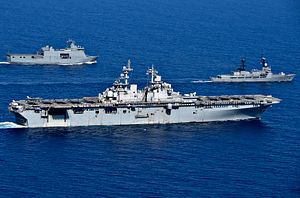For years, U.S. planners have struggled to contend with China’s use of non-military vessels in Asia’s disputed waters. Specifically, maritime law enforcement vessels and even fishing vessels have been deployed to pursue Beijing’s strategic ambitions in the East and South China Seas.
In its 2018 report on China’s military power, the U.S. Department of Defense observed that combined, the People’s Liberation Army Navy, the China Coast Guard, and China’s maritime militia “form the largest maritime force in the Indo-Pacific.” The report added that the three “sometimes conduct coordinated patrols.”
Accordingly, U.S. officials have given more prominence to this issue, openly discussing the “maritime militia” as a matter of fact. Last November, for example, former U.S. Secretary of Defense acknowledged at a press conference following talks at the second U.S.-China Diplomatic and Security Dialogue that the two sides “discussed the importance for all military, law enforcement, and civilian vessels and aircraft, including those in the PLA Navy, the Chinese Coast Guard, and the PRC Maritime Militia, to operate in a safe and professional manner.”
A report published in the Financial Times over the weekend clarified that the issue of the China Coast Guard and maritime militia were also raised at the January 2019 meeting between Admiral John Richardson, the Chief of Naval Operations for the U.S. Navy, and his Chinese counterpart, People’s Liberation Army Navy chief Vice Admiral Shen Jinlong.
In public statements around the time of his talks with Shen, Richardson had underscored risk-reduction between the two sides. “The goal of the visit is to continue a results-oriented, risk-reduction focused dialogue… routine exchange of views is essential, especially in times of friction, in order to reduce risk and avoid miscalculation,” he had said in January.
His latest clarification suggests that there was greater messaging involved. “I made it very clear that the U.S. navy will not be coerced and will continue to conduct routine and lawful operations around the world, in order to protect the rights, freedoms and lawful uses of sea and airspace guaranteed to all,” Richardson was quoted as having told the Financial Times. The report noted that Richardson had conveyed to Shen that, for the United States, China’s maritime militia and coast guard would be treated equivalently to the PLAN.
That in itself is an important overt shift in the U.S. Navy’s approach toward China. Washington has to date not had a direct response to China’s use of non-gray-hull vessels to intimidate, coerce, and even ram third-country vessels in the South China Sea, for instance. Most recently, we’ve seen China’s maritime militia deployed to coerce the Philippines in the Spratly Islands.
While the change in policy is significant, it’s not clear that it will work in the way the United States intends. If the idea of clarifying that white-hull law enforcement vessels and the maritime militia would be seen in the exact same way as PLAN vessels was designed to deter China, it has apparently not worked given the recent tensions around Thitu Island with respect to the Philippines. One possible explanation for these tensions might now involve an attempt by China to see just how credible Washington’s policy is.
In the context of the recently clarified U.S. alliance commitment to the Philippines—specifically, that “any armed attack on Philippine forces, aircraft or public vessels in the South China Sea will trigger mutual defense obligations” under the ambit of the 1951 Mutual Defense Treaty between the two countries—China may be further emboldened to test U.S. resolve.

































